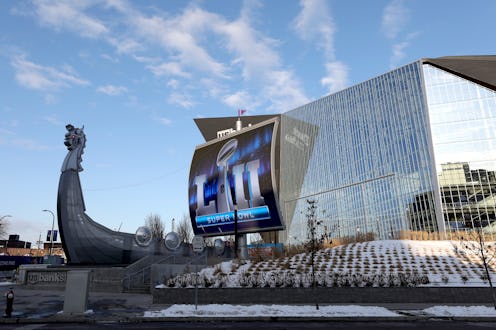News
Why Super Bowl Fans In The Stadium Will Basically Feel Like They're Outdoors

The New England Patriots faces off with the Philadelphia Eagles for Super Bowl LII in Minneapolis on Sunday, Feb. 4. Both players and fans in city for the big game Sunday will be met with frigid weather that night, but the fact that the 2018 Super Bowl's host, the U.S. Bank stadium, is heated will no doubt be a welcome perk to everyone present at the 2-year-old complex.
Unlike other newer stadiums with retractable domes, the U.S. Bank stadium has a permanent roof. Made of ETFE (ethylene tetrafluoroethylene) plastic, the ceiling is largely transparent, which serves dual purposes. It lets those inside feel like they're virtually outdoors. And by creating a greenhouse effect, it also helps keep its stadium dwellers warm throughout the winter months that can be absolutely brutal in "The North."
Roughly 60 percent of the roof is made from ETFE, so natural light is abundant in the stadium. Additionally, one entire wall is built of glass, letting in even more of the sun — and the classic outdoor vibe of stadiums past.
U.S. Bank stadium is home to the Vikings, this year's NFC runner-up team. And its singular construction has been a major draw for football fans and architecture enthusiasts alike. The stadium boasts the nation's single largest ETFE installment, and if pictures are any indication, the achievement is quite a sight to behold.
The U.S. Bank Stadium's stats are impressive. It covers 1.75 million square feet, and cost over a billion dollars to build. When the architecture firm HKS pitched three designs to the Wilf family, owner of the home team, they decided on the one that somewhat resembles a ship — a fitting choice for a team called the Vikings.
But with a predicted high of just nine degrees in Minneapolis on Sunday, game-goers will probably be most thankful for the 70-degree sweet spot provided by the stadium's permanent ETFE roof. According to Michele Kelm-Helgen, chair of Minnesota Sports Facilities Authority, the costs of installing a retractable roof couldn't be justified. At $100 million dollars, a moving roof is usually used by teams just five or six times a season. Kelm-Helgen told Architect Magazine, "HKS convinced us that the equivalent of a retractable roof was ETFE,” noting that with the additional glass wall, "you’re going to feel like you’re outside.”
And, as Marlene Cimons notes at Quartz, the U.S. Bank Stadium was built to capitalize on energy efficient technology. (It's not cheap to keep a massive indoor stadium warm in winters as frigid as Minnesota's.)
The stadium was awarded the LEED Gold certification from the US Green Building Council for its energy-saving construction.
Being one of the biggest — if not the biggest — annual sporting event in the country, all eyes are on the game in the U.S. Bank Stadium on Sunday. The stadium has the capacity to hold 66,655 people, and those who can't be there in person to catch the Patriots and Eagles play will certainly be watching on TV or on their computers, complete with the standard wings and beer fare.
The Super Bowl LII isn't the only event it's hosting for the occasion, though. The U.S. Bank Stadium held a 10-day Super Bowl festival in the run up to the big game, according to its website.
But any other Super Bowl-related event hosted in Minneapolis will surely be more affordable than the actual game itself; tickets for the 2018 game at the U.S. Bank Stadium range from $3,000 to nearly $10,000. For those who shelled out for the game, though, it will be comforting to know that they'll be watching the Super Bowl in a pretty cozy atmosphere, temperature-wise, at least.